Introduction
A career in carpentry involves a significant amount of physical labor and exposure to potential risks and hazards.
Safety practices play a crucial role in ensuring the well-being of carpenters in the UK.
By adopting and implementing proper safety measures, carpenters can minimize the likelihood of accidents, injuries, and health issues that may arise from their work environment.
The purpose of this blog section is to shed light on the importance of safety practices for carpenters, with a specific focus on the UK.
Throughout this section, we will explore the potential risks and hazards carpenters face in their profession and discuss effective safety practices to mitigate these dangers.
Join us as we delve into the world of carpentry safety, and discover how incorporating safety practices can make a significant difference in the lives of carpenters.
Overview of Carpentry in the UK
A brief explanation of carpentry as a profession in the UK
Carpentry is a skilled profession in the UK that involves the construction, installation, and repair of wooden structures.
The common tasks and responsibilities of carpenters
Carpenters perform a wide range of tasks, including measuring, cutting, shaping, and assembling wood materials to build furniture, cabinets, and other structures.
The potential risks and hazards associated with carpentry work
However, carpentry work also comes with potential risks and hazards that need to be addressed for the safety of carpenters:
Safety Hazards
- Working with sharp tools such as saws, chisels, and knives, which can cause cuts and injuries if not used properly.
- Potential falls from heights while working on ladders, scaffolding, or elevated platforms.
- Exposure to hazardous substances, such as solvents, paints, and wood dust, which can lead to respiratory problems.
Physical Hazards
- Heavy lifting and carrying of materials, which can lead to musculoskeletal injuries if proper lifting techniques are not followed.
- Inadequate ergonomics in workstations, leading to back pain, hand-arm vibration syndrome, and other repetitive strain injuries.
Electrical Hazards
- Risk of electrical shocks or electrocution when working with power tools or near live wires.
- Inadequate grounding or faulty electrical equipment that can cause electrical hazards.
Fire Hazards
- Improper storage or disposal of flammable materials, leading to the risk of fires.
- Use of heating equipment, such as welding torches, that can ignite combustible materials if not used safely.
Workplace Hazards
- Exposure to excessive noise levels from power tools or machinery, leading to hearing loss.
- Poor housekeeping practices that can result in slips, trips, and falls.
- Working in confined spaces without proper ventilation, which can cause asphyxiation or exposure to harmful gases.
It is crucial for carpenters in the UK to adhere to safety practices to minimize the risks and hazards associated with their work.
Employers must provide adequate training, personal protective equipment (PPE), and maintain a safe working environment.
Carpenters should always follow safe work procedures, use appropriate tools for each task, and regularly inspect and maintain their equipment.
They should wear personal protective equipment, such as safety goggles, gloves, hard hats, and hearing protection, to mitigate the risks.
Furthermore, carpenters should ensure proper lighting and ventilation in their work areas and implement good housekeeping practices to prevent accidents.
They should also be vigilant about identifying and reporting any potential hazards or unsafe conditions to their supervisors.
Personalized UK Career Consulting
Receive tailored career guidance designed just for you. Get actionable steps and expert support to boost your career in 1-3 days. Take control of your career now.
Get StartedBy prioritizing safety, carpenters can protect themselves from injuries and create a secure working environment for themselves and their colleagues.
Successful carpentry projects require skilled craftsmanship and attention to detail, and safety is an essential aspect of achieving success in this profession.
Legal Framework and Regulations
Relevant UK laws and regulations regarding safety practices in carpentry
In the UK, carpenters are subject to various laws and regulations aimed at ensuring their safety in the workplace.
These include:
The Health and Safety at Work Act
The Health and Safety at Work Act requires employers to provide a safe working environment, including proper training and equipment for carpenters.
The Manual Handling Operations Regulations
The Manual Handling Operations Regulations mandate the safe handling of heavy or awkward materials and equipment to prevent musculoskeletal injuries.
The Control of Substances Hazardous to Health Regulations
The Control of Substances Hazardous to Health Regulations outline the precautions that carpenters must take when working with hazardous substances such as chemicals and dust.
The Personal Protective Equipment at Work Regulations
The Personal Protective Equipment at Work Regulations require employers to provide and ensure the use of appropriate personal protective equipment, such as safety goggles and gloves, to prevent injuries.
The Construction (Design and Management) Regulations
The Construction (Design and Management) Regulations aim to ensure that construction projects are properly planned, managed, and executed, with a focus on maintaining a safe working environment for carpenters.
The Working Time Regulations
The Working Time Regulations set limits on the number of hours carpenters can work per week, with the aim of preventing fatigue-related accidents and ensuring adequate rest periods.
The Health and Safety at Work Act and other applicable regulations
Purpose of the Health and Safety at Work Act
The Health and Safety at Work Act is a key piece of legislation in the UK that governs safety practices in all industries, including carpentry.
It places a legal duty on employers to ensure the health, safety, and welfare of their employees and others who may be affected by their work activities.
Responsibilities of employers and employees
Under the Act, employers have a responsibility to conduct risk assessments, provide adequate training and supervision, and implement necessary safety measures in carpentry workplaces.
Employees are also required to cooperate with their employers to ensure their own and others’ safety.
Your Dream Job Starts with a Perfect CV
Get a tailored CV and cover letter that captures your unique strengths and stands out in your industry. Let us help you make an unforgettable first impression.
Get StartedEnforcement and penalties for non-compliance
The Act is enforced by the Health and Safety Executive (HSE) and local authorities, who have the power to inspect workplaces, investigate incidents, and prosecute non-compliant employers.
Failure to comply with the Act can result in fines, imprisonment, or both.
The significance of complying with these regulations
Ensuring the safety and well-being of carpenters
Complying with UK laws and regulations regarding safety practices in carpentry is of utmost importance for several reasons.
Preventing workplace accidents and injuries
Firstly, it ensures the safety and well-being of carpenters by minimizing the risk of workplace accidents, injuries, and long-term health issues.
By following proper safety procedures, carpenters can protect themselves from hazards inherent in their work, such as falls, cuts, and exposure to harmful substances.
Minimizing potential liability for employers
Secondly, compliance with safety regulations helps to prevent potential liability for employers.
By providing a safe working environment and complying with legal obligations, employers can reduce the risk of costly compensation claims, legal disputes, and reputational damage associated with workplace accidents.
Promoting a positive safety culture within the carpentry industry
Lastly, adhering to safety regulations promotes a positive safety culture within the carpentry industry.
It demonstrates a commitment to the well-being of workers and encourages others to prioritize safety in their practices.
By establishing a culture of safety, the industry can work towards reducing overall accidents and creating a safer environment for all carpenters.
In brief, the UK legal framework and regulations regarding safety practices in carpentry are comprehensive and encompass various aspects of workplace safety.
It is essential for carpenters and their employers to understand and comply with these regulations, as they play a vital role in ensuring the safety, health, and well-being of all individuals involved in carpentry work.
Read: Architects’ Salaries in the UK: A Comprehensive Guide
Personal Protective Equipment (PPE)
Importance of Wearing Appropriate PPE in Carpentry
Wearing appropriate personal protective equipment (PPE) is crucial for carpenters as it ensures their safety on the job.
Optimize Your LinkedIn for Success
Boost your LinkedIn profile with a professional bio, keyword-rich headline, and strategic recommendations that attract recruiters. Stand out from the crowd and get noticed.
Optimize NowPPE acts as a shield against potential hazards and reduces the risk of injuries.
As a carpenter, your most valuable asset is your body.
By wearing PPE, you protect yourself from injuries caused by falls, sharp objects, chemical exposure, and loud noises.
The use of PPE not only safeguards your physical well-being but also promotes a secure working environment.
Different Types of PPE Commonly Used in the Profession
1. Safety Goggles
Safety goggles shield your eyes from dust, debris, and harmful substances.
They have a snug fit to prevent any foreign objects from entering your eyes.
Wearing safety goggles is essential when working with power tools or in dusty environments.
2. Gloves
Gloves provide protection against cuts, punctures, abrasions, and chemical exposure.
They come in different materials such as leather, rubber, or synthetic blends.
The type of gloves you should wear depends on the specific task and potential risks involved.
3. Protective Clothing
Protective clothing includes coveralls, aprons, and high-visibility vests.
These garments offer protection against splinters, chemical spills, and hazardous substances.
Additionally, high-visibility clothing ensures visibility on construction sites, reducing the risk of accidents.
Guidelines on Selecting and Using PPE Effectively
1. Assess Risks
Before starting any carpentry task, carefully evaluate potential hazards that require the use of PPE.
Identify the specific risks associated with the job, such as flying debris, loud noises, or chemical exposure.
2. Choose the Right PPE
Select PPE that is appropriate for the identified risks.
Ensure that it fits well and is comfortable to wear during the entire duration of the task. ill-fitting or uncomfortable PPE may hinder your ability to work effectively.
3. Inspect PPE Regularly
Regularly inspect your PPE for wear and tear, damage, or signs of deterioration.
Replace any equipment that is damaged or no longer provides adequate protection. Faulty PPE can compromise your safety.
4. Proper Use and Maintenance
Follow the manufacturer’s instructions for wearing and maintaining your PPE. Store it properly when not in use to prevent damage.
Clean your PPE regularly to ensure it functions effectively.
5. Training and Awareness
Provide comprehensive training to all carpenters on the correct usage, limitations, and maintenance of PPE.
Ensure everyone is aware of the potential risks and understands the importance of adhering to safety practices.
Remember, using PPE is not a substitute for other safety practices.
It should be part of a comprehensive safety program that includes risk assessments, training, and regular safety inspections.
By prioritizing the use of appropriate PPE, carpenters can significantly reduce the likelihood of accidents, injuries, and long-term health complications.
Safe carpentry practices, reinforced by the use of PPE, promote a secure and productive working environment.
Read: UK Architectural Landmarks: History & Significance
Hazard Identification and Risk Assessment
Identifying Potential Hazards in Carpentry Work
Identifying potential hazards in carpentry work is crucial to ensure the safety of carpenters in the UK.
This process involves carefully examining the work environment, tools, and materials used in carpentry tasks.
It is essential to be aware of common hazards such as falling objects, sharp tools, exposed electrical wires, and unsafe scaffolding.
Additionally, potential hazards can include working at heights, using power tools, and working with hazardous substances.
To identify potential hazards, carpenters should conduct thorough inspections of their worksite and equipment.
Regular checks should be performed to ensure that equipment is in proper working condition and that safety features are intact.
Importance of Conducting Risk Assessments
Conducting risk assessments before starting a task is essential to prevent workplace accidents and injuries.
Risk assessments help carpenters identify potential hazards, evaluate their likelihood of occurrence, and determine the severity of the risk.
By conducting a risk assessment, carpenters can develop strategies to control or eliminate hazards to minimize the risks involved.
This proactive approach allows for the implementation of necessary precautions to protect workers’ health and safety.
Risk assessments also enable carpenters to prioritize tasks based on the level of risk associated with each activity.
This ensures that the most hazardous tasks are addressed with appropriate control measures in place.
Assessing Risks and Implementing Precautions
To assess risks and implement necessary precautions, carpenters can follow these practical tips:
- Identify potential hazards: Carefully examine the working environment and equipment to identify any potential risks. Look out for sharp edges, slippery surfaces, unsecured tools, and electrical hazards.
- Evaluate the likelihood and severity of risks: Determine how likely it is for a hazard to occur and the potential consequences if it does. This evaluation helps prioritize control measures for higher-risk activities.
- Involve workers in the risk assessment process: The insights of experienced carpenters can be invaluable in identifying potential hazards and assessing risks. By involving workers, a more comprehensive assessment can be conducted.
- Implement control measures: Once hazards are identified and assessed, carpenters should implement appropriate control measures. This may include providing personal protective equipment (PPE), ensuring proper tool maintenance, and establishing safe work procedures.
- Regularly review and update risk assessments: Risk assessments should be reviewed regularly and updated whenever conditions change. New hazards may emerge, and control measures may need to be adjusted to maintain a safe work environment.
By following these steps, carpenters can effectively identify potential hazards and assess the associated risks.
This proactive approach minimizes the chance of accidents or injuries, promoting a safe working environment for carpenters in the UK.
In general, hazard identification and risk assessment are fundamental in ensuring the safety of carpenters in the UK.
By identifying potential hazards and conducting thorough risk assessments, carpenters can implement necessary precautions to mitigate risks and protect their well-being.
Regular reviews and updates of risk assessments are crucial to address changing conditions and maintain a safe working environment.
Read: Major Plumbing Issues in UK Homes

Safe Handling and Use of Tools
The significance of using tools properly and safely
- Proper and safe use of tools is essential for carpenters to prevent accidents and injuries.
- Using tools correctly ensures efficient work and produces quality results.
- Neglecting tool safety can lead to serious injuries, such as lacerations, fractures, or even amputations.
- Employers have a legal responsibility to provide proper training and ensure tools are used safely.
- Workers should always follow manufacturer guidelines and receive necessary training to use specific tools.
Common tools used in carpentry and their associated risks
- Hammers: Can cause hand injuries, such as bruising or fractures, if not used with proper grip and control.
- Saws: Improper use of saws can lead to severe cuts or amputations, especially when not using safety guards.
- Chisels: Sharp chisels can cause deep cuts if not handled carefully or misused. Proper hand protection is crucial.
- Screwdrivers: Inappropriate use or applying excessive force can result in slips or puncture wounds.
- Power Tools (e.g., drills, nail guns): These tools can cause severe injuries when not operated with caution and adequate training.
Guidelines on maintenance, sharpening, and safe storage of tools
- Regularly inspect tools for damage and wear, such as loose handles or rusted blades, and replace or repair them immediately.
- Follow manufacturer instructions for sharpening blades or edges, ensuring they are kept in excellent cutting condition.
- Store tools in a designated area that prevents damage, such as hanging them on a tool rack or placing them in durable cases.
- Organize and secure tools properly to avoid tripping hazards or accidental contact with sharp edges.
- Maintain a clean and clutter-free workspace to reduce the risk of tools being mishandled or misplaced.
In a nutshell, proper handling and use of tools are of utmost importance in ensuring the safety of carpenters.
It is crucial to understand the risks associated with common carpentry tools and take necessary precautions to prevent accidents.
Employers should provide the necessary training and ensure that workers follow manufacturer guidelines.
Regular maintenance, sharpening, and safe storage practices help prolong the lifespan of tools while preventing injuries.
By prioritizing tool safety, carpenters can create a safe and productive work environment.
Read: Historical Evolution of Plumbing in UK
Working at Heights
Risks and Challenges
- Carpentry involves working at elevated heights, which poses various risks and challenges.
- There is a high potential for falls, which can result in serious injuries or even fatalities.
- Unprotected edges or openings, unstable surfaces, and improper use of equipment contribute to the risks.
- Weather conditions such as rain, snow, or wind can also increase the dangers of working at heights.
- Improper training or lack of awareness about safety procedures adds to the potential hazards.
- Failure to recognize and address these risks can lead to accidents and disastrous consequences.
Methods for Fall Prevention
- Using scaffolding is one effective method for preventing falls when working at heights.
- Scaffolds should be properly erected, inspected regularly, and equipped with guardrails to ensure safety.
- Fall protection systems, such as harnesses and safety nets, should also be utilized.
- Carpenters should receive proper training on how to use fall protection equipment correctly.
- Regular maintenance and inspection of fall protection systems are crucial to their effectiveness.
- Implementing a buddy system, where carpenters work in pairs, can increase safety during elevated tasks.
Ladder Safety and Secure Footing
- Whenever possible, alternatives to ladders should be considered for working at heights.
- If ladders are necessary, ensure they are in good condition, free from defects, and suitable for the task.
- Inspect the ladder before each use to check for any damages or loose parts.
- Always maintain three points of contact when climbing or descending a ladder.
- Make sure the ladder is placed on a stable and level surface, avoiding slippery or uneven ground.
- Use ladder levelers or stabilizers to improve stability and prevent side-to-side movement.
- Never overreach while on a ladder, as it can result in loss of balance and falls.
- Keep areas around the ladder clear of any obstacles and ensure it is secured at the top and bottom.
- Do not carry heavy or bulky materials while climbing a ladder; use a hoist or pulley system instead.
- If working near electrical sources, use non-conductive ladders to prevent electric shock.
Working at heights in carpentry presents significant risks, but by implementing proper safety measures, the dangers can be minimized.
Understanding the challenges, utilizing fall prevention methods, and practicing ladder safety with secure footing are essential for carpenters to work safely and avoid accidents.
Prioritizing safety not only protects the well-being of carpenters but also ensures the success of projects and the reputation of the industry.
Proper Material Handling and Storage
Risks associated with improper handling and storage of materials in carpentry
- The risks associated with improper handling and storage of materials in carpentry are numerous. Heavy lifting and carrying can result in back injuries and strains.
- Tripping hazards are also prevalent when materials are scattered around the workspace.
- Mishandling or improper storage can lead to damage to materials, potentially impacting the quality and safety of finished carpentry projects.
- Furthermore, poorly organized work areas increase the risk of accidents and injuries.
Guidance on lifting techniques and weight limits
- To mitigate these risks, carpenters should follow proper lifting techniques and adhere to weight limits.
- By keeping the back straight and bending the knees while lifting, the risk of back injuries can be significantly reduced.
- It is important to ask for assistance when dealing with heavy materials that exceed individual lifting capabilities.
- Carpenters should also be aware of weight limits and restrictions specific to different types of materials and equipment.
- Utilizing tools such as carts or dollies can make transportation of heavy items easier and safer. In cases where the load is extremely heavy, mechanical aids like cranes or forklifts should be used.
Importance of organized and safe storage areas
- Organized and safe storage areas are crucial in carpentry. By designating specific storage areas for materials, accidents and injuries can be prevented.
- Materials should be stored in a way that ensures stability and prevents them from falling or collapsing.
- It is vital to keep aisles and pathways clear from obstructions to facilitate safe movement and navigation.
- Regular inspection of storage areas is necessary to identify and address hazards such as sharp edges, protruding nails, or unstable racks.
- Following a systematic inventory management system enables carpenters to keep track of stored materials, ensuring efficient handling and preventing any unnecessary risks.
In summary, practicing proper material handling and storage techniques is vital for carpenters to maintain a safe and secure work environment.
By understanding the risks associated with improper handling and storage, following recommended lifting techniques and weight limits, and organizing storage areas efficiently, carpenters can significantly reduce the likelihood of accidents and injuries, resulting in a safer and more productive workspace.
Training and Education
Importance of Proper Training
Carpenters must prioritize receiving adequate training to ensure safety practices are followed effectively.
Available Training Programs and Certifications
- The Construction Industry Training Board (CITB) offers a range of training programs specifically for carpenters in the UK.
- The Health and Safety Executive (HSE) also provides guidance on recognized qualifications and certifications related to carpentry safety.
Resources and Recommendations for Skill Enhancement
- Online courses: Carpenters can explore various online platforms that offer safety training specific to carpentry.
- Apprenticeships: Apprenticeship programs provide valuable hands-on experience, coupled with proper safety training.
- Safety workshops and seminars: Attending these events can provide carpenters with the latest safety practices and techniques.
- Professional associations: Joining organizations such as the Institute of Carpenters can offer access to resources and networking opportunities.
- Continuous learning: Carpenters should consistently update their knowledge through reading relevant publications, websites, and industry journals.
- Mentoring programs: Experienced carpenters should act as mentors to provide guidance on safety practices to their apprentices.
- Tool and equipment training: Carpenters should familiarize themselves with the correct usage and maintenance of tools and equipment to prevent accidents.
- Regular safety reviews: To stay informed on current safety practices, carpenters should regularly review safety guidelines and procedures.
- Communication and teamwork: Foster a culture of open communication and collaboration, ensuring everyone is aware of and follows safety protocols.
By emphasizing the importance of proper training, carpenters can enhance their skills, knowledge, and, most importantly, their safety practices.
The availability of training programs and certifications ensures access to effective training resources.
Carpenters should strive to continuously enhance their skills through various channels such as online courses, apprenticeships, workshops, and professional associations.
Moreover, they should stay informed about the latest safety guidelines, promote safe tool usage, and cultivate a culture of open communication.
By investing in education and training, carpenters can create a safer working environment for themselves and their colleagues in the UK.
See Related Content: Types of Welding Jobs Available in the UK
Conclusion
In this blog post, we discussed the safety practices that are vital for carpenters in the UK.
These practices are not just guidelines, but important measures that can prevent accidents and injuries.
It is crucial for carpenters to prioritize their safety by implementing these practices in their profession.
By doing so, they can ensure a safer work environment and reduce the risk of accidents and harm.
The use of personal protective equipment, proper tool handling, and maintaining a clean workspace were highlighted.
We also stressed the importance of regular training and communication among carpenters to enhance safety.
Safety should always be the top concern for carpenters, and by following these practices, they can achieve it.
Carpenters need to be responsible and proactive in implementing these measures to protect themselves and their colleagues.
By taking safety seriously, carpenters can avoid unnecessary injuries and create a more productive work environment.
Let us all commit to making safety a priority in the carpentry profession and safeguard the well-being of all involved.
[E-Book for Sale]
500 Cutting-Edge Tech Startup Ideas for 2024 & 2025: Innovate, Create, Dominate
$19.99 • 500 Tech Startup Ideas • 62 pages
You will get inspired with 500 innovative tech startup ideas for 2024 and 2025, complete with concise descriptions to help you kickstart your entrepreneurial journey in AI, Blockchain, IoT, Fintech, and AR/VR.




